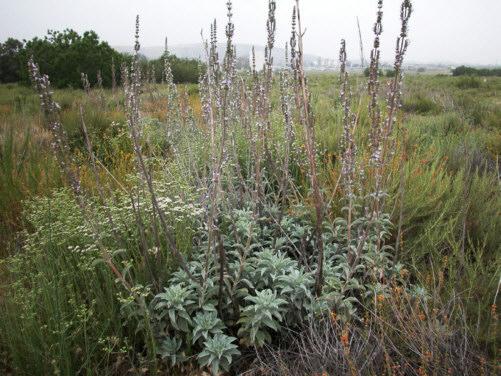|
Also known as Sacred
sage, is an evergreen perennial shrub of the genus Salvia, the sages.
It is native to the southwestern United States and northwestern Mexico,
being found mainly in California on the western edges of the Mojave
and Sonoran deserts.
Stems and leaves are usually white from the presence of fine hairs.
The leaves start out crinkly grey-green and become smooth and white.
These plants typically reach 6 ft. in height. They are shrubby below,
with the current year's growth being long, erect branches on which flowers
appear at the tips. Flowers are white with a little lavender and bloom
from late spring to midsummer.
White sage likes dry slopes, full sun, and no extra water. It is not
specific to any one soil, growing in sandy loam, granitic scree, and
red loamy clay. They grow on dry benches and slopes below 1500 metres.
Bumblebees, hawk moths and wasps pollinate the White sage, and hummingbirds
also appear to like the plant.
Native Americans had several uses for this plant: seeds were ground
into a flour and used for mush; leaves were used for flavoring in cooking;
leaves were also eaten, smoked or used in a sweathouse as a remedy for
colds; seeds were dropped into the eye and permitted to roll around
under the eyelids in order to cleanse the eyes; and leaves were crushed
and mixed with water to create a hair shampoo, dye and straightener.
White sage is considered sacred by many Native Americans, being used
to make smudge, or smudge wands, a type of incense. It is believed to
cleanse a space of any evil spirits that may be present. This power
is said to be released from the plant by the burning of the leaves,
which are typically bundled into a wand or stick. White sage was used
in a similar fashion by the Celts.
|


